We've spent a lot of time discussing training for deployment, what personal supplies we'd bring to a deployment, and what radio gear we would bring along, but what to do for antennas?
Yes, roll-up or J-pole antennas have been discussed often for years; to a lesser extent we have discussed low-flying HF (NVIS) antennas. We never know where our deployments may send us, and in many cases trees or other antenna supports may be some distance away, so extra coax and/or rope will be handy in those instances.
But there may be times where we don't have a tree or pole or other support to hang an antenna on, so other options for supporting antennas may be necessary. A few options will be presented here, but it would be interesting to hear of any others as well.
Tripods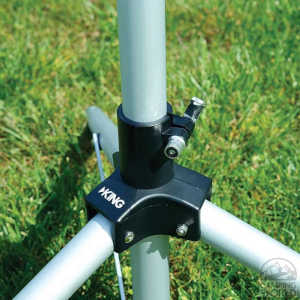 These may not allow for a lot of elevation, but a tripod can certainly provide a good base for a VHF antenna or as a support for a NVIS HF antenna. The do have the disadvantage of being easily tipped if not anchored or guyed. Simple metal or plastic tent stakes can be used to anchor the tripod or provide attachment points for guy wires.
These may not allow for a lot of elevation, but a tripod can certainly provide a good base for a VHF antenna or as a support for a NVIS HF antenna. The do have the disadvantage of being easily tipped if not anchored or guyed. Simple metal or plastic tent stakes can be used to anchor the tripod or provide attachment points for guy wires.
Weighted Buckets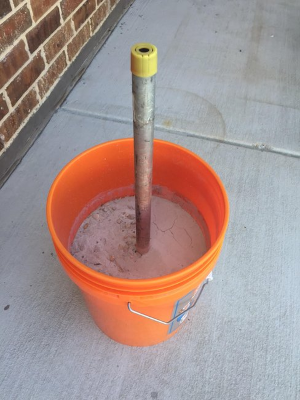 A bucket filled with concrete, with a piece of pipe (or center-hole to slide a pipe into) can be used to insert a mast, may actually provide better support and balance than a tripod, and is cheap to make. Three could be used in conjunction to act as a tripod base.
A bucket filled with concrete, with a piece of pipe (or center-hole to slide a pipe into) can be used to insert a mast, may actually provide better support and balance than a tripod, and is cheap to make. Three could be used in conjunction to act as a tripod base.
Guyed Masts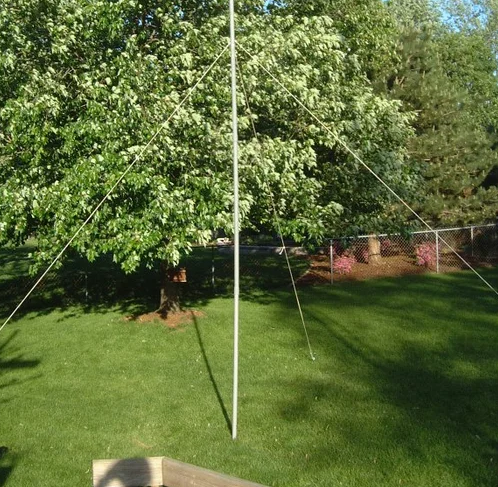 While a tripod is handy, it isn't entirely necessary if you're willing to put a little more effort into setting up. You can stand the mast using guys, although I've had poor luck with this method myself. Tent or other anchors act as tie-downs for three or more guys attached to the mast. This would probably be my last choice.
While a tripod is handy, it isn't entirely necessary if you're willing to put a little more effort into setting up. You can stand the mast using guys, although I've had poor luck with this method myself. Tent or other anchors act as tie-downs for three or more guys attached to the mast. This would probably be my last choice.
Hitch/Receiver Mounts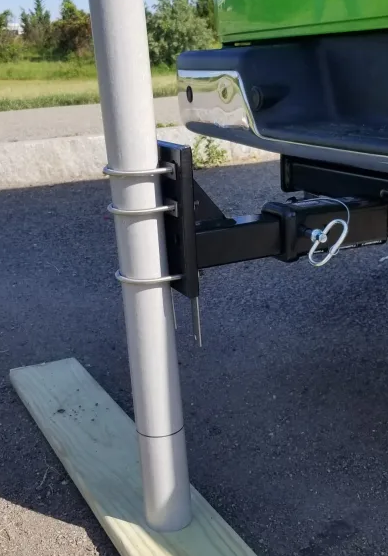
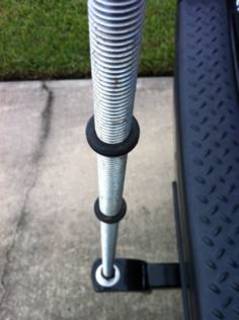 Variations of these have been around for decades. Towing Receivers are great for this, as your vehicle's weight, the strength of the hitch, and the range of mounting options combine to create a flexible and robust system for erecting antennas.
Variations of these have been around for decades. Towing Receivers are great for this, as your vehicle's weight, the strength of the hitch, and the range of mounting options combine to create a flexible and robust system for erecting antennas.
A variety of designs use the receiver natively, using the appropriately sized square tubing, while others use receiver attachments that allow masts or other hardware to be mounted. Either method works well, and it's unlikely you'll exceed the capacity of the receiver!

N4FWD pointed out there are drive-on "mounts" available. Just set the stand down, drive your car's tire on top of the foot, and you're ready to drop your mast into the base. Simple, and readily available from DX engineering.
The Mast itself
There are a variety of options for the actual mast, ranging from military surplus fiberglass in sections, PVC, wood, to telescoping aluminum masts. One ingenious individual proposed using a $99 Harbor Freight Telescoping Flag Pole!
Additional Resources
https://km1ndy.com/tow-hitch-mast-support-for-ham-radio-beam-antennas/
https://www.eham.net/article/26744
https://www.instructables.com/Portable-PVC-Conduit-Antenna-Mast/
https://swling.com/blog/tag/low-profile-ham-radio-antenna/
https://www.dxengineering.com/parts/sbm-mdcs-100




